Non-traditional news story forms go by many names: charticles, non-narratives, storytelling devices, alternative story forms, ASFs and alts, among others. Some stand alone as a story, and some are supplemental: forms that clarify, complement and explain information in a traditional news story.
Here’s a look at some supplemental forms, with tips on how to use them effectively.
If You Go: This textbox type tells readers how they can participate in a news event such as a city council meeting or street festival. A “who, what, when” format often works well here.
Tips Box: Often presented as a bullet-point list, the tips box gives readers advice on how to accomplish a task, attend an event or even how to vote.
Breakout: This flexible form can be used to summarize the main point of a story or to focus on a detail that may heighten reader interest.
Pros and Cons: Often presented in a grid format, this form lets readers compare two or more points of view.
What’s Next: This story form describes the next step in a news story. It’s useful for long-running stories and gives a forward-looking view to your coverage.
Update: This form lists the latest developments in a story. It’s often used online to tell readers how this story is different from ones about the same news event that they may have read earlier.
Characters: Because some stories have many sources, this textbox can help the reader sort them out, offering short biographical information as well as explaining the role of each “character” in a news event.
Glossaries: Some topics in the news have their own jargon or terms. Glossaries help readers understand those terms by defining them more simply.
Story So Far: Do readers know the “story so far” on Aleppo, the indictment of a lawmaker or the fight over a proposed highway? This type of textbox gives readers the back story on the news. It’s like a flashback in a movie that explains the motivation of the characters. News stories have characters and motivations, too, and readers want to know what they are.
Bio Box: These miniature biographies give fast facts on people, places or companies. The basics (birth date, hometown, education) are obvious, but these also can include trivia (favorite movie, pet peeve, etc.) about the subject of the bio box.
Taken from Beyond the Inverted Pyramid: Creating Alternative Story Forms, a self-directed course by Andy Bechtel at Poynter NewsU.
Have you missed a Coffee Break Course? Here’s our complete lineup. Or follow along on Twitter at #coffeebreakcourse.







